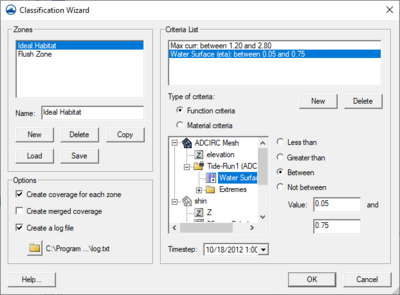SMS:Zonal Classification
At a glance
- Generate a map coverage identifying areas that meet specific requirements
- Requirements can be based upon dataset values such as less than a specific value or based upon materials in an area property coverage
Zonal classification is a tool that will identify areas that meet a set of criteria. The criteria can be based upon scalar dataset values and/or specific material ids in a coverage.
A zone may contain one or more criteria. A zone may identify areas that have a range of depths and also a range of velocities. Multiple zones can be evaluated at the same time. If you are using multiple zones, you can have SMS create a separate coverage for each zone, a coverage that includes all the zones where each polygon's material identifies the zone or zones the polygon is valid for, or both a coverage for each zone and a merged coverage.
Zones and criteria associated with them can be saved and loaded from within SMS. This makes it easier to evaluate multiple scenarios using the same set of criteria.
If desired, SMS can create a log file that contains information such as the areas found in each zone.
Example
One application of zonal classification is to help quantify the amount and quality of fish habitat. Certain types of fish prefer or require different depths, velocities, and substrate. These preferences depend upon the life-cycle stage for fish.
The following demonstrates how you could use zonal classification for a very simplified example to identify areas meeting a certain set of criteria. The example is fictitious and uses made up criteria.
For the first sample criteria we will identify areas that have an elevation of 5 ft or less. This is done by:
- Creating a new zone based upon this criteria.
- Creating a new criteria based upon a functional criteria.
- Specify the elevation dataset and the criteria to be less than 5 ft.
After executing the zonal classification a new coverage was created and polygons identify the areas that meet the requirements of the zone (in our case the elevation less than 5 ft). Assuming that our criteria identifies a target habitat, it is easy to see the areas that meet the criteria.
In addition to the elevation, let's assume that our target habitat also requires a specific type of substrate (bottom sediment type). For this example, we have created polygons in a area property coverage and identified areas with different substrates (again this information is fictional).
We added another criteria to our original zone so that the zone only includes areas that have clay substrate.
Now polygons only exist where the elevation is less than 5 ft and the substrate is clay.
External Links
- Vector based classification of zones from distributed datasets or GIS polygon data - Russell D. Jones, 2003 - Thesis (M.S.) Brigham Young University Dept. of Civil and Environmental Engineering. TA 4.02.J65482 2003
Related Topics
Modules: Mesh Module · Cartesian Grid Module · Scatter Module · Map Module · GIS Module · Particle Module
Models: ADCIRC · BOUSS-2D · CGWAVE · CMS-Flow · CMS-Wave · FESWMS · FVCOM · Generic Mesh Model · GENESIS · HYDRO AS-2D · PTM · SRH-2D · Steering · STWAVE · TABS · TUFLOW
